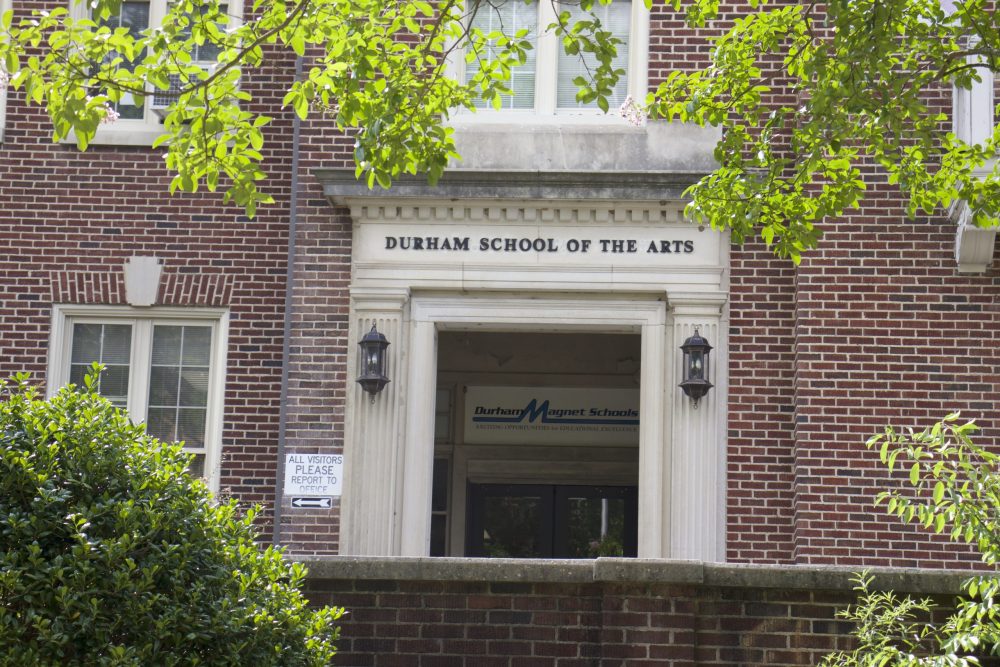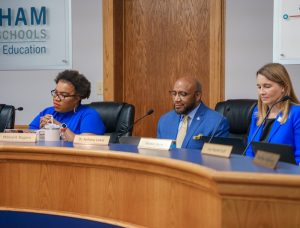When the Durham School of the Arts moves to a new location by 2027, a 17-acre plot of land including several buildings and spanning three downtown blocks will lie deserted. While the final beam of steel in the construction of the new DSA campus was placed on Nov. 19, plans for the current campus property have yet to be established.
Some community members and organizations are advocating for the planning process to start now.
Steven Unruhe, a board member of the Trinity Park Neighborhood Association (TPNA) and former Durham school board member, penned an Indy Week op-ed in September proposing different ways to make full use of the property.
“At some point, you have to plan what’s going to come next,” Unruhe reiterated in an interview. “So if you don’t start now, you’re just pushing everything back and then you’re lengthening the amount of time that the campus is sitting empty.”
Another TPNA resident and DSA parent, Marcie Porter, presented a letter to the school board at a meeting on Sept. 25, asking the school board to commit to a “formal planning process for the future use, preservation, and stewardship of the existing Durham School of the Arts campus.”
The issue came up again on Nov. 19 at a joint meeting of the school board and county commissioners, when local housing advocate Jim Svara suggested using the property for affordable housing.
In the past, school board members indicated an intention to use the property for educational purposes, but gave few details. Beyond that, response from the district on this issue has been limited.
According to Bettina Umstead, the chair of the Durham school board, plans for DSA will be part of broader conversation about district buildings.
“Durham Public Schools is currently in the process of developing a Capital Improvement Plan where we are assessing all facilities including Durham School of the Arts and evaluating their use,” she wrote in an email to The 9th Street Journal. “With the average age of our DPS facilities at 60 years old, it is important that we develop a comprehensive plan to enhance learning and work environments for students and educators across the district.”
Meanwhile, community members grow restless, concerned that delays to the planning process will spell unnecessary costs to the district.
“Moving forward on the planning really should start now because…the longer those buildings sit empty, you’ve still got to maintain them…heat them, air condition them, [and]…provide security,” John Hodges-Copple, a retired regional planner, said. “There’s going to be [sunk] costs associated with those empty buildings…that detract from other things the school system would be doing with their facility dollars.”
“People in the community all say ‘amen, it should be happening.’ The problem is that I don’t hear much from the elected officials,” Unruhe said, frustration palpable in his voice.
School board members did not respond to Unruhe’s op-ed, although County Commissioner Michelle Burton sent him a note of support, he said. Porter, the TNPA resident who appeared before the school board, received an email from school board member Natalie Beyer thanking her for submitting the letter requesting action.
Community members have set forth a number of proposals on what the district should do with different parts of the property, chief among them the development of affordable housing.
“Things could happen pretty quickly on that three-acre site…,” Hodges-Copple said. “To me, that is the prime location for any affordable housing project.”
At a joint meeting of the board of county commissioners and the board of education on Nov. 19, Svara, the housing advocate, independently spoke of the same three-acre site. The property, he said, “would provide perhaps the only option for a large affordable housing development that is close to the rail trail [slated for completion in 2027].”
“We hope that construction can start when students have moved to their new site…,” Svara added. “We would like to get this planning effort going.”
Other suggestions include repurposing the property for new athletic facilities, DPS administrative offices (in the historic central building), and a small middle or high school (in the existing middle school building), to name a few.
“I really do think that preserving the history [of DSA] and the unique place that it occupies should be a part of what guides the vision,” said Porter.
What happens to the property, according to Hodges-Copple, will largely “depend on who can bring resources to the table” — resources that the school system lacks. “[DPS has] great trouble even maintaining all the other buildings and sites they have, many of which are not used,” he said.
Many hope that community input will play a role in deciding what to do with the property. In his op-ed, Unruhe suggested that the district hire a community engagement firm to survey the community and democratically collect ideas.
“There’s so many organizations that are very interested in what happens there, ranging from the neighborhoods around the site to the Historic Preservation Society…to the downtown supporters…,” said Hodges-Copple.
“The best solution usually comes out of some really creative cooperation between all the groups,” he added.
Until the planning process has begun, however, any ideas remain just that—ideas.
“I just hope that a decision-making process can be started now with a reasonable timeline,” Porter said, “so that the property doesn’t end up vacant, taped off with caution tape for months or years.”




